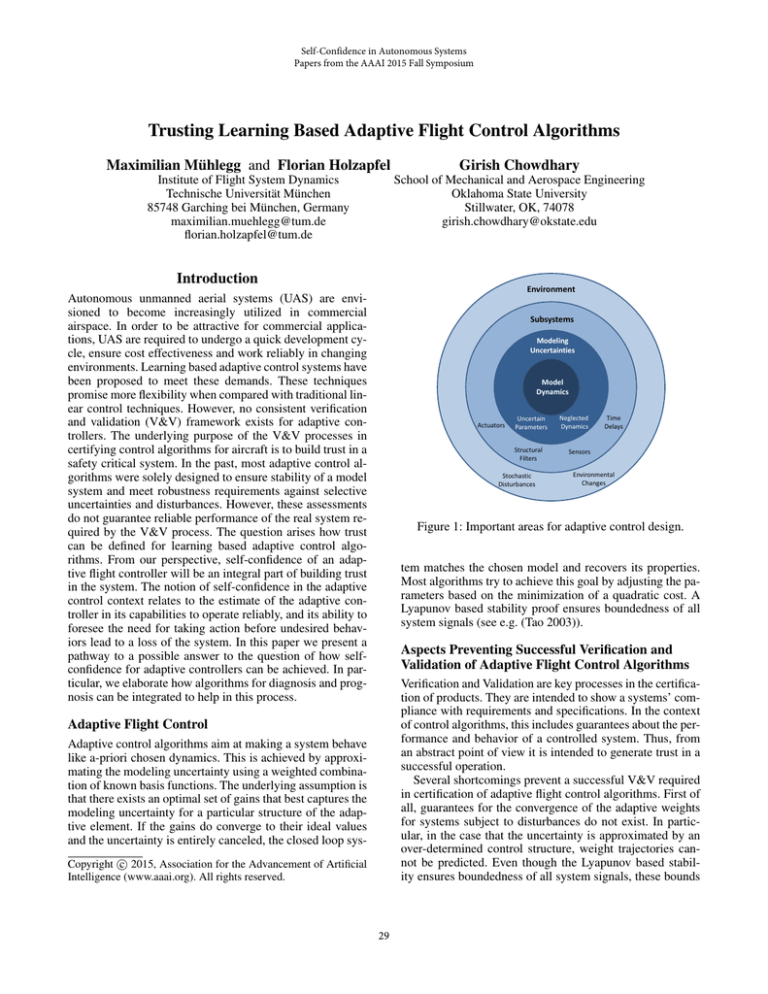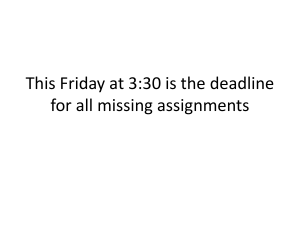
Self-Confidence in Autonomous Systems
Papers from the AAAI 2015 Fall Symposium
Trusting Learning Based Adaptive Flight Control Algorithms
Maximilian Mühlegg and Florian Holzapfel
Girish Chowdhary
Institute of Flight System Dynamics
Technische Universität München
85748 Garching bei München, Germany
maximilian.muehlegg@tum.de
florian.holzapfel@tum.de
School of Mechanical and Aerospace Engineering
Oklahoma State University
Stillwater, OK, 74078
girish.chowdhary@okstate.edu
Introduction
Environment
Autonomous unmanned aerial systems (UAS) are envisioned to become increasingly utilized in commercial
airspace. In order to be attractive for commercial applications, UAS are required to undergo a quick development cycle, ensure cost effectiveness and work reliably in changing
environments. Learning based adaptive control systems have
been proposed to meet these demands. These techniques
promise more flexibility when compared with traditional linear control techniques. However, no consistent verification
and validation (V&V) framework exists for adaptive controllers. The underlying purpose of the V&V processes in
certifying control algorithms for aircraft is to build trust in a
safety critical system. In the past, most adaptive control algorithms were solely designed to ensure stability of a model
system and meet robustness requirements against selective
uncertainties and disturbances. However, these assessments
do not guarantee reliable performance of the real system required by the V&V process. The question arises how trust
can be defined for learning based adaptive control algorithms. From our perspective, self-confidence of an adaptive flight controller will be an integral part of building trust
in the system. The notion of self-confidence in the adaptive
control context relates to the estimate of the adaptive controller in its capabilities to operate reliably, and its ability to
foresee the need for taking action before undesired behaviors lead to a loss of the system. In this paper we present a
pathway to a possible answer to the question of how selfconfidence for adaptive controllers can be achieved. In particular, we elaborate how algorithms for diagnosis and prognosis can be integrated to help in this process.
Subsystems
Modeling
Uncertainties
Model
Dynamics
Actuators
Uncertain
Parameters
Structural
Filters
Stochastic
Disturbances
Neglected
Dynamics
Time
Delays
Sensors
Environmental
Changes
Figure 1: Important areas for adaptive control design.
tem matches the chosen model and recovers its properties.
Most algorithms try to achieve this goal by adjusting the parameters based on the minimization of a quadratic cost. A
Lyapunov based stability proof ensures boundedness of all
system signals (see e.g. (Tao 2003)).
Aspects Preventing Successful Verification and
Validation of Adaptive Flight Control Algorithms
Verification and Validation are key processes in the certification of products. They are intended to show a systems’ compliance with requirements and specifications. In the context
of control algorithms, this includes guarantees about the performance and behavior of a controlled system. Thus, from
an abstract point of view it is intended to generate trust in a
successful operation.
Several shortcomings prevent a successful V&V required
in certification of adaptive flight control algorithms. First of
all, guarantees for the convergence of the adaptive weights
for systems subject to disturbances do not exist. In particular, in the case that the uncertainty is approximated by an
over-determined control structure, weight trajectories cannot be predicted. Even though the Lyapunov based stability ensures boundedness of all system signals, these bounds
Adaptive Flight Control
Adaptive control algorithms aim at making a system behave
like a-priori chosen dynamics. This is achieved by approximating the modeling uncertainty using a weighted combination of known basis functions. The underlying assumption is
that there exists an optimal set of gains that best captures the
modeling uncertainty for a particular structure of the adaptive element. If the gains do converge to their ideal values
and the uncertainty is entirely canceled, the closed loop sysc 2015, Association for the Advancement of Artificial
Copyright Intelligence (www.aaai.org). All rights reserved.
29
Recently, Kullback-Leibler (KL) divergence has attracted
increased attention as a metric, which measures how the belief in a system changes over time. The underlying idea is
to measure the difference between the posterior P and the
prior distribution Q in a Bayesian setting (Axelrod 2015):
Z ∞
p(x)
p(x)ln
DKL (P kQ) =
dx.
(2)
q(x)
−∞
Therefore, it also presents an interesting approach to try and
predict future changes in the uncertainty estimation.
Neither diagnostics nor prognosis alone will be able to
allow assertions about the health of the controller. Rather,
a measure of confidence will arise from a combination of
both areas. Additionally, the intrinsic properties of different
adaptive control methods can help build self-confidence. A
guaranteed convergence of the adaptive weights to a close
vicinity of their true values can be related to a reduction
in the predictive covariance (see e.g. (Chowdhary, Mühlegg,
and Johnson 2014)). Also the technique itself might already
supply some sort of self-confidence (see e.g. Bayesian techniques in (Chowdhary et al. 2014)). Our ongoing work includes extensions to these techniques such that either a measure of the learning confidence can be leveraged by the system to navigate to safe regions of the state space or switch
controllers, ultimately reducing the probability of a system
loss.
are often utterly conservative and physically unreasonable
and still might cause a system to crash due to physical constraints. Furthermore, most adaptive control developments
only take a part of the system, shown in Fig. 1, into account;
in particular, subsystems and effects from the environment
are often neglected. Hence, the stability proof might not even
hold when transported to an experimental system.
A crucial point in the V&V process of linear flight controllers are analytically derived performance and robustness
guarantees in the form of metrics such as phase and gain
margin. Unfortunately, such universal metrics do not exist
for nonlinear controllers. Hence, an a-priori analytical evaluation of the adaptive controller is not possible with the current state-of-art.
Role of Diagnosis and Prognosis for Health
Monitoring of Learning Based Adaptive Control
Algorithms
There seems to be an emerging consensus between various
authors that if an a-priori analytical evaluation of the adaptive controller is not possible, monitoring and health assessment during its run-time will be an integral part of verifying
adaptive controllers in the future (see e.g. (Jacklin 2008)).
Aligned with this direction of thought, we propose a pathway to monitoring and health assessment inclusive of two
steps, diagnostics and prognosis.
Diagnostics involve quantifying a belief in the current
uncertainty approximation capabilities of the adaptive controller and identify undesired behavior, such as excessive
weight oscillations or parameter drift, from onboard available data. Online monitoring approaches of the control algorithm can help gauge self-confidence in its current performance. Existing approaches rely on data driven techniques
such as Bayesian regression. They try to determine whether
the adaptive weights have converged and the predictive covariance is sufficiently small (Schumann and Yan Liu 2007),
or if a significant change in the control output from previously observed behavior occurred (Szukalski, Mühlegg, and
Johnson 2015). Using the data set D and the current state
z, the latter is achieved by inferring a probability Pζ from
a predictive distribution p(y|z, D) whether the adaptive output y is within a ζ threshold of the most probable output
yM P :
Z yM P +ζ
Z yM P −ζ
Pζ =
p(y|z, D)dy −
p(y|z, D)dy. (1)
−∞
References
Axelrod, A. M. 2015. Learning to exploit time-varying heterogeneity in distributed sensing using the information exposure rate. Master’s thesis, Oklahoma State University.
Cámara, J. 2013. Assurances for self-adaptive systems:
Principles, models, and techniques, volume 7740. Berlin
and New York: Springer.
Chowdhary, G.; Kingravi, H. A.; How, J. P.; and Vela, P. A.
2014. Bayesian nonparametric adaptive control using gaussian processes. IEEE Transactions on Neural Networks and
Learning Systems PP(99).
Chowdhary, G.; Mühlegg, M.; and Johnson, E. 2014. Exponential parameter and tracking error convergence guarantees
for adaptive controllers without persistency of excitation. International Journal of Control 87(8):1583–1603.
Jacklin, S. 2008. Closing the certification gaps in adaptive
flight control software. In AIAA Guidance, Navigation, and
Control Conference.
Schumann, J., and Yan Liu. 2007. Tools and methods for the
verification and validation of adaptive aircraft control systems. In IEEE Aerospace Conference, 1–8.
Szukalski, R.; Mühlegg, M.; and Johnson, E. 2015. Consistency monitoring of adaptive controllers using bayesian
linear regression. In American Control Conference, 177–
182.
Tao, G. 2003. Adaptive control design and analysis. Hoboken and N.J: Wiley-Interscience.
Wang, L. 2009. Model Predictive Control System Design
and Implementation Using MATLABr. London and Heidelberg: Springer.
−∞
Markovian models are used for formal verification purposes
and pose an interesting extension to the online monitoring
algorithms (Cámara 2013).
The second step deals with prognosticating future behavior. The goal is to answer the question whether the system still abides stability and performance requirements for a
fixed future time horizon given the current circumstances.
One approach adopts the strategy of model predictive control (Wang 2009): the model used for the control design is
employed along diagnostic results in order to predict future
states. Each region is associated with a probability of occurrence, thus allowing for a statistical quantification of how
likely a state limit transition is.
30



